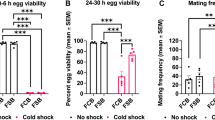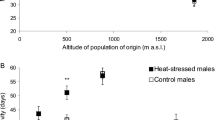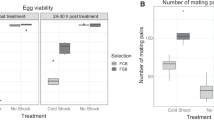Abstract
Tolerance to extreme temperatures is one of the most important components of adaptation to environments in insects. However, the genetic mechanisms of tolerance to long-term heat stress are mostly unknown. In this study, we investigated the genetic variation of susceptibility to long-term heat stress among the isofemale strains of Drosophila prolongata Singh & Gupta. High rates of pupal lethality were observed at 25 °C, showing that D. prolongata is more susceptible to heat stress than other Drosophila species. Susceptibility to heat stress was significantly different among the isofemale strains, suggesting that intraspecific genetic variation is involved in the reduced heat tolerance of D. prolongata. Unexpectedly, the tertiary sex ratio was biased to females at temperatures higher than 20 °C, indicating that the males were more susceptible to heat stress. These results demonstrated that D. prolongata is useful for genetic analysis for elucidating the molecular mechanisms of heat tolerance in insects.
Similar content being viewed by others
Avoid common mistakes on your manuscript.
Introduction
Since insects are ectothermic and their body temperature is easily affected by environmental conditions, they have developed various mechanisms to cope with lower and higher extremes of ambient temperature. Physiological mechanisms of tolerance to lower thermal stresses are relatively well studied. Numerous insect species survive at temperatures below 0 °C, and they avoid freezing by deep supercooling of body fluids through the synthesis of antifreeze proteins and accumulation of carbohydrate cryoprotectants (Crosthwaite et al. 2011), or endure freezing by freezing only the extracellular spaces by synthesis of ice nucleating agents or proteins (Wharton 2011). In contrast, the molecular mechanisms of heat tolerance are mostly unknown except for the heat shock proteins (HSPs), which are expressed in response to brief heat stress and repair denatured proteins as molecular chaperones (Parsell and Lindquist 1993). Considering global warming and its effect on the habitat range of agricultural pests, it is important to extend our knowledge about the molecular mechanisms of insect heat tolerance, particularly in response to long-term heat treatment.
Drosophila fruit flies have been used for genetic and evolutionary analysis of heat tolerance. Variation in heat tolerance among 94 Drosophila species from diverse climates has been shown to reflect phylogenetic inertia rather than habitat distributions (Kellermann et al. 2012). Chromosomal inversions related to temperature adaptation have been a longstanding subject of studies in Drosophila pseudoobscura Frolova & Astaurov and D. subobscura Collin (Calabria et al. 2012; Dobzhansky 1935). Because of the well-established genome annotation and detailed information about gene functions, D. melanogaster Meigen and its closely related species are amenable models for genetic analysis of insect heat tolerance to elucidate its molecular mechanisms.
Drosophila prolongata Singh & Gupta is a member of the Melanogaster species group. Their native habitat is woods in mountainous areas, where the average temperature is relatively low (Singh and Gupta 1977; Toda 1991). In this study, the long-term heat tolerance of D. prolongata was examined. It was revealed that the upper thermal limit of D. prolongata was lower than those of other Drosophila species. There was a significant difference in long-term heat tolerance among the isofemale strains, suggesting that intraspecific genetic variation was involved in the reduced heat tolerance of D. prolongata. Unexpectedly, the tertiary sex ratio was extremely biased to females at 25 °C, suggesting that sex-specific developmental processes are a target of heat stress. These results could serve as the basis of further genetic analysis of reduced heat tolerance in D. prolongata to elucidate the molecular mechanisms of heat tolerance in insects.
Materials and methods
Drosophila prolongata strains
The isofemale strains used in this study were described previously (Kudo et al. 2015). Each strain was established from a single mated female and has been maintained by inbreeding for more than 100 generations. All the strains were reared on ordinary cornmeal medium for Drosophila culture at 20 °C in a 12:12 h light:dark cycle.
Survival rate at different temperatures
Sexually mature adults (seven male and female individuals each) were introduced into a plastic vial (28.5 mm diameter × 95 mm height; Thermo Fisher scientific, Waltham, USA) with cornmeal medium and allowed to mate and oviposit for 3 days at 20, 23, and 25 °C. The neonate larvae (at most 30 individuals) were transferred to a new plastic vial with cornmeal medium, and incubated at the same temperature. The number of pupae and emerged adults were scored for each vial. The sex was determined for all emerged adults. More than two replications were made for each strain and temperature condition. Pupation rate was calculated as the proportion of the number of pupae to the number of neonate larvae. Eclosion rate was calculated as the proportion of the number of emerged adults to the number of pupae. Length of developmental period from the egg to eclosion was recorded individually. Pupation rate, eclosion rate, and sex ratio were analyzed using generalized linear models (GLMs) with a binomial distribution and a logit link function including “strain”, “temperature”, and their interaction as explanatory variables. Developmental period was analyzed using GLMs with a gamma distribution and a log link function including “strain”, “temperature”, “sex”, and their interactions as explanatory variables. The effect of each variable was assessed using a likelihood ratio test, in which a reduction in deviance by adding the explanatory variable to a reduced model was examined. Spearman’s rank correlation coefficient was used for the analysis of correlation between sex ratio and eclosion rate, which was calculated for individual strains at 23 °C. All analyses were conducted using R version 3.1.1 (R development core team 2008).
Reproduction at 23 °C
Adults that emerged from the experiment with incubation at 23 °C were used. Females and males (seven individuals each) at least 5 days after eclosion were allowed to mate and oviposit at 23 °C, and hatched larvae were transferred to a new vial, and the number of pupae and hatched adults were scored in the same way as described above.
Results
Effect of temperature on length of developmental period
In most strains, the developmental period from the egg to adult eclosion was shorter at the higher temperature (Table 1). Males required a significantly longer developmental period than females at any temperature (Tables 1, 2). Length of the developmental period was also significantly different among the strains. The effect of the interaction between sex and temperature was not significant, indicating that the influence of temperature was not different between the sexes (Table 2). On the other hand, the effect of the interaction between strain and temperature was significant, suggesting that the response to high temperature was different among the strains.
Lethality induced by long-term heat stress
The survival rate (proportion of the number of emerged adults to that of neonate larvae inoculated into the vial) was lower at higher temperatures (Fig. 1). Although both pupation rate and eclosion rate were significantly different among temperatures (GLM, χ 2 = 22.8, df = 2, p < 0.001 and χ = 1142.4, df = 2, p < 0.001, respectively), the majority of dead individuals at 25 °C were observed during pupal stages, showing that the eclosion rate was more severely affected than the pupation rate by heat-induced lethality (Fig. 1c). The eclosion rate was significantly different between 20 and 23 °C (GLM, χ 2 = 37.1, df = 1, p < 0.001), as well as between 23 and 25 °C (GLM, χ 2 = 741.7, df = 1, p < 0.001), suggesting that the effect of heat stress increased progressively. The effect of interactions between strains and temperatures on eclosion rate was significant (GLM, χ 2 = 171.2, df = 28, p < 0.001), showing that the sensitivity to long-term heat stress varied among the isofemale strains.
Survival rate of Drosophila prolongata at a 20 °C, b 23 °C, and c 25 °C. Proportions of individuals that died during larval stages (larval lethal, black), died during pupal stages (pupal lethal, dark gray), and emerged as adults (emerged, light gray) are shown for each strain. The sample size is noted below each bar. At most 30 individuals were examined in a single vial, and two to five replications were made for each strain and temperature
There was a correlation between eclosion rate and tertiary sex ratio; the lower the eclosion rate, the more female-biased the sex ratio (Fig. 2). The sex ratio was significantly different among temperatures (GLM, χ 2 = 107.3, df = 2, p < 0.001). When the dead pupae were dissected, the sex ratio was male-biased among those that had developed to the sex-dimorphic stages (data not shown), suggesting that heat stress led to male-biased lethality in D. prolongata. In this sense, secondary sex ratio was not likely to be changed by heat stress (but see “Discussion”).
Correlation between eclosion rate and sex ratio (proportion of males). Each point represents a strain reared at 20 °C (square), 23 °C (circle), or 25 °C (triangle). The line indicates linear regression (y = 0.62x – 2.49). Spearman’s rank correlation coefficient was r 2 = 0.59 for the data at 23 °C, which was significantly different from zero (p = 0.022)
Reproductive defects at 23 °C
Although the eclosion rate was significantly reduced at 23 °C, most strains reproduced at this temperature, except for SaPa002 which laid eggs that did not hatch. Observation of the internal reproductive organs revealed that SaPa002 males reared at 23 °C did not produce any sperm, whereas females of the same strain produced eggs normally (data not shown), suggesting that SaPa002 was sterile because of temperature-sensitive defects in spermatogenesis. Reduction in sperm number was not observed in the other strains. Because the eclosion rate of SaPa002 at 23 °C was as high as other strains (Fig. 1b), the mechanism of the defect in spermatogenesis could be independent from that of heat-induced lethality.
Discussion
Compared with other Drosophila species, D. prolongata was more sensitive to heat stress. For example, D. melanogaster and D. simulans Sturtevant survive at higher temperatures up to 32 and 31 °C, respectively (Petavy et al. 2001). The optimal temperature for these species is approximately 25 °C, at which D. prolongata suffered heat-induced lethality. This result was consistent with the thermal condition of their natural habitat. In one of the original collection sites, SaPa, Vietnam, average maximum temperature during summer season (June–August) is 24 °C, while average minimum temperature during winter season (December–February) is 7 °C. Adaptation to cool conditions might have resulted in the elevated sensitivity to heat stress. A large proportion of the lethality was observed during pupal stages. Developmental processes for metamorphosis may be more sensitive to long-term heat stress than larval development. Alternatively, effects of heat stress accumulated during larval period might lead to pupal lethality. In this sense, it is interesting that heat-induced lethality seemed to be male-biased, as discussed below. Because males of D. prolongata have exceptional morphology compared with other Drosophila species, specific developmental processes involved in the evolution of D. prolongata might be responsible for the elevated sensitivity to heat stress in this species.
Unexpectedly, the tertiary sex ratio was biased towards females at higher temperatures in D. prolongata. Biases in sex ratio at high temperature have been reported in other insects. Most examples are known from parasitoid wasps, in which the sex ratio was biased towards males at high temperature. For example, by controlling the fertilization of eggs, females of Trichogramma euproctidis (Girault) actively produce more males than females at high temperature resulting in distortion of secondary sex ratio (Moiroux et al. 2014). Another example is the sex manipulation by Wolbachia infection. Wolbachia is an endosymbiotic bacterium that infects a wide range of species and is known to manipulate the host tertiary sex ratio for their own fitness towards females by killing males (Werren et al. 2008). Heat treatment eliminated Wolbachia and restored the tertiary sex ratio to the normal state in Drosophila bifasciata Pomini (Hurst et al. 2000). Other examples of heat-induced sex ratio distortion are extremely limited. The tertiary sex ratio was biased towards males in the parasitoid fly Bessa parallela (Meigen) (Ichiki et al. 2003) and the thrip Scolothrips longicornis Priesner (Pakyari et al. 2011) at high temperature, whereas it was biased to females in the lady beetle Propylea dissecta (Mulsant) (Omkar and Pervez 2004). The mechanisms of sex ratio distortion are unknown in these three cases. In D. prolongata, the biased tertiary sex ratio was suggested to be the result of male-biased lethality during the pupal stages. There is prominent sexual dimorphism in D. prolongata; males are larger than females and have enlarged forelegs. Larger body size and specific morphology of the appendages may require more complex metamorphosis in males. In fact, the developmental period of D. prolongata was significantly longer in males at any temperature (Tables 1, 2), suggesting that males have specific developmental processes which could be more sensitive to heat stress than those of females. Nevertheless, it was not excluded that the secondary sex ratio was also affected by heat stress. Detailed examination is required to confirm this possibility.
Since temperature is one of the most important factors that influence the physiology of insects, studying the genetic mechanism of heat tolerance is essential for understanding the adaptation of insects to natural conditions. However, we know little about the genes involved in heat tolerance except for Hsp70 (Bettencourt and Feder 2001; Chen et al. 2014; Tungjitwitayakul et al. 2015). Other genes were sought in D. melanogaster using QTL mapping, but individual genes have not been identified (Takahashi et al. 2011). In the present study, D. prolongata was shown to be sensitive to heat stress, with variable sensitivity among isofemale strains. Genetic analysis of these strains could lead to further understanding of the genetic and molecular mechanisms of adaptation to heat stress in insects.
References
Bettencourt BR, Feder ME (2001) Hsp70 duplication in the Drosophila melanogaster species group: how and when did two become five? Mol Biol Evol 18(7):1272–1282. doi:10.1093/oxfordjournals.molbev.a003912
Calabria G, Dolgova O, Rego C, Castaneda LE, Rezende EL, Balanya J, Pascual M, Sorensen JG, Loeschcke V, Santos M (2012) Hsp70 protein levels and thermotolerance in Drosophila subobscura: a reassessment of the thermal co-adaptation hypothesis. J Evol Biol 25(4):691–700. doi:10.1111/j.1420-9101.2012.02463.x
Chen H, Xu XL, Li YP, Wu JX (2014) Characterization of heat shock protein 90, 70 and their transcriptional expression patterns on high temperature in adult of Grapholita molesta (Busck). Insect Sci 21(4):439–448. doi:10.1111/1744-7917.12057
Crosthwaite JC, Sobek S, Lyons DB, Bernards MA, Sinclair BJ (2011) The overwintering physiology of the emerald ash borer, Agrilus planipennis fairmaire (Coleoptera: Buprestidae). J Insect Physiol 57(1):166–173. doi:10.1016/j.jinsphys.2010.11.003
Dobzhansky T (1935) Fecundity in Drosophila pseudoobscura at different temperatures. J Exp Zool 71:449–464
Hurst GDD, Johnson AP, von der Schulenburg JHG, Fuyama Y (2000) Male-killing Wolbachia in Drosophila: a temperature-sensitive trait with a threshold bacterial density. Genetics 156(2):699–709
Ichiki R, Takasu K, Shima H (2003) Effects of temperature on immature development of the parasitic fly Bessa parallela (Meigen) (Diptera: Tachinidae). Appl Entomol Zool 38(4):435–439. doi:10.1303/aez.2003.435
Kellermann V, Overgaard J, Hoffmann AA, Flojgaard C, Svenning JC, Loeschcke V (2012) Upper thermal limits of Drosophila are linked to species distributions and strongly constrained phylogenetically. Proc Natl Acad Sci USA 109(40):16228–16233. doi:10.1073/pnas.1207553109
Kudo A, Takamori H, Watabe H, Ishikawa Y, Matsuo T (2015) Variation in morphological and behavioral traits among isofemale strains of Drosophila prolongata (Diptera: Drosophilidae). Entomol Sci 18(2):221–229. doi:10.1111/ens.12116
Moiroux J, Brodeur J, Boivin G (2014) Sex ratio variations with temperature in an egg parasitoid: behavioural adjustment and physiological constraint. Anim Behav 91:61–66. doi:10.1016/j.anbehav.2014.02.021
Omkar, Pervez A (2004) Temperature-dependent development and immature survival of an aphidophagous ladybeetle Propylea dissecta (Mulsant). J Appl Entomol 128(7):510–514. doi:10.1111/j.1439-0418.2004.00881.510-514
Pakyari H, Fathipour Y, Enkegaard A (2011) Effect of temperature on life table parameters of predatory thrips Scolothrips longicornis (Thysanoptera: Thripidae) fed on twospotted spider mites (Acari: Tetranychidae). J Econ Entomol 104(3):799–805. doi:10.1603/EC10144
Parsell DA, Lindquist S (1993) The function of heat-shock proteins in stress tolerance—degradation and reactivation of damaged proteins. Annu Rev Genet 27:437–496. doi:10.1146/annurev.ge.27.120193.002253
Petavy G, David JR, Gibert P, Moreteau B (2001) Viability and rate of development at different temperatures in Drosophila: a comparison of constant and alternating thermal regimes. J Therm Biol 26(1):29–39. doi:10.1016/S0306-4565(00)00022-X
R Development Core Team (2008) R: a language and environment for statistical computing. R foundation for statistical computing, vienna, Austria. ISBN 3-900051-07-0, http://www.R-project.org
Singh BK, Gupta JP (1977) Two new and two unrecorded species of the genus Drosophila fallen (Diptera: Drosophilidae) from Shillong, Meghalaya, India. Proc Zool Soc 30:31–38
Takahashi KH, Okada Y, Teramura K (2011) Genome-wide deficiency screen for the genomic regions responsible for heat resistance in Drosophila melanogaster. BMC Genet 12:57. doi:10.1186/1471-2156-12-57
Toda MJ (1991) Drosophilidae (Diptera) in Myanmar (Burma) VII. The Drosophila melanogaster species-group, excepting the D. montium species-subgroup. Orient Insects 25:69–94
Tungjitwitayakul J, Tatun N, Vajarasathira B, Sakurai S (2015) Expression of heat shock protein genes in different developmental stages and after temperature stress in the maize weevil (Coleoptera: Curculionidae). J Econ Entomol 108(3):1313–1323. doi:10.1093/jee/tov051
Werren JH, Baldo L, Clark ME (2008) Wolbachia: master manipulators of invertebrate biology. Nat Rev Microbiol 6(10):741–751. doi:10.1038/nrmicro1969
Wharton DA (2011) Cold tolerance of New Zealand alpine insects. J Insect Physiol 57(8):1090–1095. doi:10.1016/j.jinsphys.2011.03.004
Acknowledgments
This work was supported by JSPS KAKENHI Grant Number 26660263 to TM.
Author information
Authors and Affiliations
Corresponding author
Rights and permissions
About this article
Cite this article
Hitoshi, Y., Ishikawa, Y. & Matsuo, T. Intraspecific variation in heat tolerance of Drosophila prolongata (Diptera: Drosophilidae). Appl Entomol Zool 51, 515–520 (2016). https://doi.org/10.1007/s13355-016-0425-4
Received:
Accepted:
Published:
Issue Date:
DOI: https://doi.org/10.1007/s13355-016-0425-4






